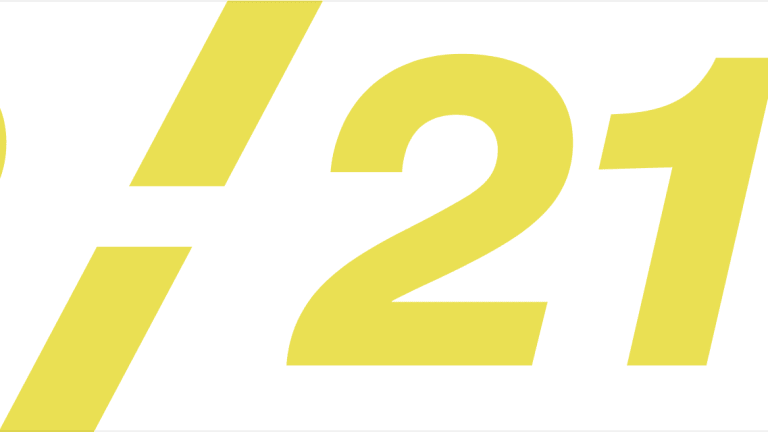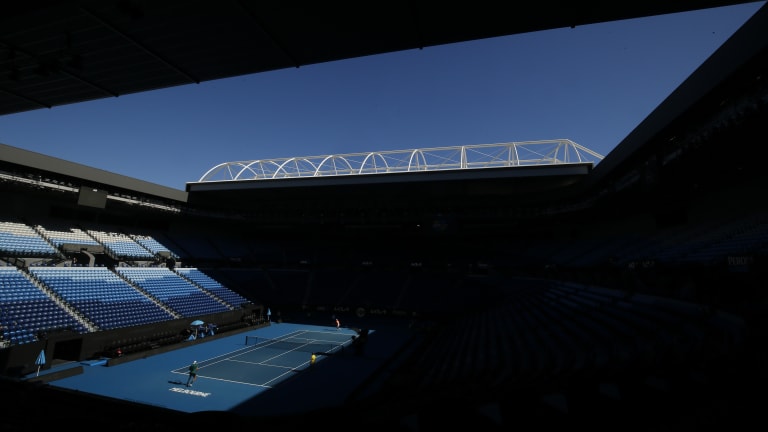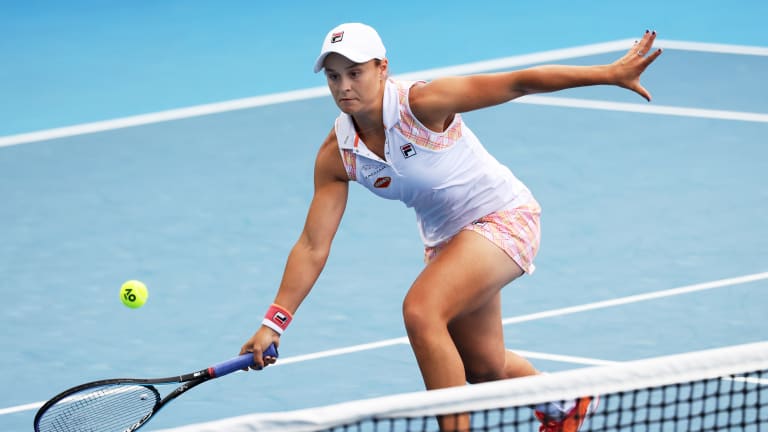The Tennis.com Round-Robin: 2021 Australian Open Edition
Feb 05, 2021Roger Federer to headline “Battle of the World No.1s” at Australian Open’s inaugural Opening Ceremony
By TENNIS.com Dec 11, 2025Australia at Last: Reflections on a first trip to the AO
By Jon Levey Jan 29, 2025Alexander Zverev must elevate his game when it most counts—and keep it there
By Peter Bodo Jan 27, 2025Jannik Sinner draws Novak Djokovic comparisons from Alexander Zverev after Australian Open final
By Steve Tignor Jan 26, 2025Alexander Zverev left to say "I'm just not good enough" as Jannik Sinner retains Australian Open title
By Matt Fitzgerald Jan 26, 2025Jannik Sinner is now 3-0 in Grand Slam finals after winning second Australian Open title
By TENNIS.com Jan 26, 2025Taylor Townsend and Katerina Siniakova win second women's doubles major together at the Australian Open
By Associated Press Jan 26, 2025Madison Keys wins her first Grand Slam title at Australian Open by caring a little bit less
By Steve Tignor Jan 25, 2025Henry Patten, Harri Heliovaara shrug off contentious first set to win Australian Open doubles title
By Associated Press Jan 25, 2025The Tennis.com Round-Robin: 2021 Australian Open Edition
With the year's first Slam about to begin, our team tackles three big-picture questions.
Published Feb 05, 2021
Advertising
Nestled between January's summer swing of tournaments in Australia, and March's Sunshine Double in the U.S., February can be overlooked in tennis. But not in 2021, with the Australian Open's temporary move to the second and shortest month of the calendar. Beyond that, February is Black History Month, and also a pivotal time for the sport in its rebound from the pandemic.

The Tennis.com Round-Robin: 2021 Australian Open Edition
Advertising
To commemorate this convergence of events, we're spotlighting one important story per day, all month long, in The 2/21. Set your clock to it: it will drop each afternoon, at 2:21 Eastern Standard Time (U.S.).
Matt Fitzgerald: There are plenty of player-driven choices—a Barty Party at home, no more 24 talk for Serena, Novak’s ninth Down Under. But for me, it would be pulling off a fan-attended event of this size, after bringing in well over 1,000 visitors to a place with zero COVID cases, and not causing any harmful consequences. That in itself would provide strong encouragement that sports can return to their former self—in some shape—if the right work is done.
Nina Pantic: With all of the new factors at play this year, we’re bound to see some Cinderella runs, akin to what happened at Roland Garros. (Remember Nadia Podoroska?) Expect to see someone relatively new come out from nowhere and make a legitimate push for the final weekend, like a Marie Bouzkova or Jannik Sinner.
Cale Hammond: The last unseeded men’s Grand Slam champion was Gaston Gaudio, at Roland Garros in 2004. But even then, Gaudio was 26 years old. We’re long overdue. The thought of an unseeded champion on the men’s feels like an impossibility, but it has to happen again at some point, right?
Steve Tignor: If everything works out, the most memorable aspect of the AO may be the presence of crowds. Officials are hoping for more than 300,000 spectators; the sight of them will be inspiring, and hopefully motivating, for the rest of the world.
Peter Bodo: This is clearly a trick question because it would be impossible to choose one—not with Serena running around, Djokovic resurgent, Swiatek and Kenin. But the really intriguing, nuanced storyline to my mind is how the Aussies will fare. They have a lot of talent now, but their history (with the exception of Lleyton Hewitt) in their home Slam has been pitiable. Can they turn it around?
Ashley Ndebele: The readjustment of match scheduling due to ongoing positive COVID-19 cases. As we have seen in the last few weeks, the government officials in Victoria aren’t willing to take any chances, and so will be ready to send players into isolation as soon as a positive case pops up. What that means for the tournament at large is anyone's guess.
Jordaan Sanford: She drops to the ground in disbelief—arms thrown towards the sky—and a smile begins to emerge as the pressure quickly fades. Serena Williams captures Grand Slam title No. 24. The chase comes to an end where she hoisted her last major title, four years ago. After being one win away from tying Margaret Court’s record on four occasions, she does it when adversity is at an all-time high. It’s a storyline that would never be lost in the history books.

The Tennis.com Round-Robin: 2021 Australian Open Edition
© Getty Images
Advertising
David Kane: The three post-pandemic majors have differed so much in protocol that differences itself may be all that they have in common. Players in Melbourne are enjoying familiar access to the city ahead of the Australian Open, but only after many fulfilled the strictest of quarantine measures. They've survived so many plot twists in the last 12 months that those who continue expecting the unexpected may be at an advantage over those fixated on disrupted routines.
Ed McGrogan: In Flushing Meadows, I watched Kyle Edmund yell as loud as he could to his team of four, after hitting a winner to practically no reaction: “SAY SOMETHING!” There will be much more of a crowd Down Under, but the players may still need to generate some of their own energy.
Van Sias: Playing to a packed crowd on the main stage at one of the Grand Slams is what every professional—from world No. 1s to seasoned veterans to up-and-comers—dreams about. At the US and French Opens last year, there was barely any audience to speak of. Motivation, more than ever, had to come from within. There’s supposed to be fairly decent fan attendance in Melbourne, but if something was to change drastically, the players know that they’ll be OK.
Jon Levey: Those draws lacked attendance from several headliners, and players like Iga Swiatek and Dominic Thiem took advantage to win their first Slams. On the other hand, Alexander Zverev stole defeat from the jaws of victory. Preparation for the AO has been limited to say the least, and many will be playing their way into form. If opportunity knocks, best answer.
Joel Drucker: The phrase “champions adapt” has never been more vivid than over the last 12 months. Last year’s chance to return to competition amid austere conditions helped each player experiment with various preparation and recovery rituals. How now do they process competition? It will be intriguing to see how this plays out in Melbourne.
Kamakshi Tandon: Players should find the Australian Open a lot more “normal” than either the French or the US Opens, but what they experienced at those events should lead them to appreciate the lessened restrictions a lot more. The challenge might be concentrating on tennis instead of newly reacquired freedoms, like going to Melbourne's famed coffee shops.

The Tennis.com Round-Robin: 2021 Australian Open Edition
© Getty Images
Advertising
Men, First Quadrant
Steve Tignor: Can anyone stop Novak Djokovic? There are some quality players here, including Gael Monfils, Stan Wawrinka, Taylor Fritz, Milos Raonic and the huge-serving Reilly Opelka. And Djokovic's potential quarterfinal opponent, Alexander Zverev, nearly beat him in ATP Cup. But you bet against the Serb in Melbourne at your peril. Dark Horse: Zverev
Men, Second Quadrant
Kamakshi Tandon: This is a blockbuster quarter with talent lurking. Dominic Thiem is the highest seed and still looks like the favorite despite a lackluster start. Nick Kyrgios now says he's injured, and others have some tough first rounds—Shapovalov plays Sinner, Dimitrov's got Cilic, Carreno Busta opens against Nishikori. Dark Horse: The usually solid Diego Schwartzman, though the lead-up has been so unusual it's tough to assess the level of the players.
Matt Fitzgerald: All things considered, Dominic Thiem’s draw isn’t horrible. But Jannik Sinner’s breakout quarterfinal run at RG started with taking out No. 11 seed David Goffin. He opens with No. 11 seed Denis Shapovalov here. Sinner benefited from two weeks of exclusive training with Rafa in Adelaide, and looks sharp in Melbourne. If he hits through Shapo, there’s no reason the teen can’t turn it into a deeper run. Dark Horse: Felix Auger-Aliassime and his fresh new Adidas look.
Men, Third Quadrant
Peter Bodo: Quarter three of the draw speaks with a distinct Russian accent, It’s anchored by No. 4 seed Daniil Medvedev with his countryman, Andrey Rublev (No. 7), projected as his quarterfinal opponent. Both men are in menacing form. Survivor: Rublev stays hot, wins revenge match with Medvedev. Dark Horse: No. 12 seed Roberto Bautista Agut is a very tough out.
Jordaan Sanford: At this point it’s really hard to bet on anyone else coming through this section other than Daniil Medvedev. The world No. 4 is on a 12-match winning streak and has already produced solid straight-set wins against Diego Schwartzman and Kei Nishikori at this week’s ATP Cup. Apparently, there’s no quarantine rust to shake off for the Russian. Dark Horse: Borna Coric
Men, Fourth Quadrant
Joel Drucker: A quarterfinal matchup between Stefanos Tsitsipas and Rafael Nadal is a highly viable possibility. But compelling as that match between those passionate competitors could be, I’ll favor Nadal to reach the semis. Dark Horse: the perpetually dangerous Matteo Berrettini.
Nina Pantic: Stefanos Tsitsipas has thrived in Melbourne before, and there’s no reason he can’t make another major semifinal, or his first final. Rafael Nadal sits in his section, of course, but nothing will be predictable this fortnight. Tsitsipas has a shot at his second career win over the world No. 2. Dark Horse: Tennys Sandgren. He’s twice reached the quarterfinals, unseeded.

The Tennis.com Round-Robin: 2021 Australian Open Edition
© Getty Images
Advertising
Women, First Quadrant
David Kane: Led by hometown hero Ashleigh Barty, the Aussie crowd will be hoping for a second-round derby between the world No. 1 and wildcard Daria Gavrilova. With No. 6 Karolina Pliskova looking out of sorts and the top seed showing little rust in her Melbourne Park warm-up, Barty looks like the one to beat should she get past a streaky Ekaterina Alexandrova. Dark Horse: unseeded 2019 semifinalist Danielle Collins could steal the spotlight from them both.
Women, Second Quadrant
Ashley Ndebele: Victoria Azarenka has a tough opening-round foe in Jessica Pegula but since returning from the COVID-induced break, the 31-year-old has been playing solid tennis. She’s in the same quarter as defending champion Sofia Kenin, but Azarenka has lifted the Happy Slam trophy twice. Her third one is long overdue. Dark Horse: Jennifer Brady has never been past the fourth round in Melbourne, but her confidence-filled bucket should aid her this time around.
Cale Hammond: Jennifer Brady will need to get through Konta and Kenin, but if she’s firing on all cylinders she has the most dangerous game of the three. I think the free points she earns on serve will help propel her through this section. Dark Horse: Maria Sakkari has been playing fantastic. Given the massive army of Greek supporters she’ll have in Melbourne, she is a serious threat to reach her first major semifinal.
Women, Third Quadrant
Ed McGrogan: Osaka, Kvitova and Muguruza have all had great success in Melbourne, making this a truly tough call. But I’ll go with Garbine, who at her very best might have the highest ceiling of these three. Dark Horse: Can it actually be the No. 8 seed, Bianca Andreescu? She hasn’t played in 15 months. An interesting unseeded option is Caroline Garcia, who could meet Osaka in round two.
Women, Fourth Quadrant
Jon Levey: Iga Swiatek’s first test could be a fourth-round date with Halep, who she walloped last year in Paris. Plus, Halep has a feast or famine history in Oz, and I’m betting the under. Sabalenka and Serena will beat the mental and physical stuffing out of each other in a slugfest, leaving Swiatek to mop up the pieces in the quarters. Dark Horse: Elena Rybakina